Diagnostic Catalog of Artifacts (earthenware, stoneware, porcelain, and some small finds)
1/137
There's no tags or description
Looks like no tags are added yet.
Name | Mastery | Learn | Test | Matching | Spaced |
|---|
No study sessions yet.
138 Terms
What are three types of clay ceramics
earthenware, stoneware, and porcelain
Which of the tree types of ceramics is fired at the lowest temperature?
earthenware is fired at the lowest temperature.
What temperature is earthenware fired at?
typically between 900-1050 degrees C
What kind of ceramic is earthenware? (think characteristics)
porous
What do you do if you don’t want your ceramic to be porous?
you glaze them
What kind of glaze is typically used for earthenware?
lead glaze
What is porcelain made of?
Specialized white clay
what temperature is porcelain fired at?
> 1300 degrees
Describe what the glaze on porcelain looks like
It doesn’t really look like a glaze as it is practically bonded to the bodies, which is why everyone wanted porcelain
For those who couldn’t afford porcelain, how would they make mock ups?
they would add a bit of tin to the lead glazed earthenware to make it look more like porcelain
Is porcelain usually decorated?
yes, porcelain is often decorated
Where did North-devon gravel temper come from?
southwest England
What color does north-devon gravel temper glaze have?
usually has apple green lead glaze and is unglazed on the other side with gravel in it
What kind of vessels are typically made of North devon gravel temper?
utilitarian vessels
What is Buckley?
A lead glazed ceramic
On how many sides is Buckley glazed on?
Two sides
What color paste does Buckley have?
brick-red to purplish earthenware paste
What is Buckley made of?
Two different kinds of clays
When does Staffordshire-type first show up around?
Around the 1680s
What is Staffordshire-type ware typically used for?
Drinking vessels
is staffordhire-type ware typically decorated?
Some are highly decorated
Describe Staffordshire slip-ware in terms of economic class
Staffordshire slipware is not the most wealthy symbol
What kind of appearance does stoneware have?
It has a stone-like appearance
How can you tell the difference between earthenware and stoneware?
If you lick it, earthenware will stick to your tongue
What are two kinds of Rhenish earthenware?
Rhenish Blue on Gray and Rhenish Brown
What is the time frame for Rhenish Brown?
1634-1690
What kind of face mask does Rhenish brown ware have?
Bellermy face-mask
What kinds of vessels was Rhenish Brown used for and what were the purposes of those vessels?
It was typically used for bottles that held liquids but not wine.
Where are the face masks on Rhenish Brown bottles typically found in terms of site locations?
They are often found in Native Sites in which the bottles have often be repurposed
What is Rhenish Blue on Gray typically used for?
Mugs or jugs
What does GR on Rhenish Blue on Gray mean?
George Rex- the King
When was English Brown stoneware dated to?
1690 (but in reality it was earlier than that- around 1624)
What do English Brown stonewares have on the base?
Small dark inclusions in the base
What are White salt-glazed stonewares typically used for?
mugs, lids, saucers, teapots
Why was white salt-glazed stone ware sought after?
Because they wanted whiter pottery
What would happen if you threw salt at the White salt-glazed stoneware and why?
It would pelt like an orange peel because it is very thin
What can be added to earthenware to create an opaque glaze?
Tin oxide
What color paste do earthenwares fired at a low temperature have?
The color can range from buff to yellow to pink to red to gray and the paste is soft and porous
Which type are some of the most plentiful ceramics found on colonial archaeological sites?
Coarse earthenware
What kind of ceramic is Astbury-type?
Thinly potted Earthenware
What color body does Astbury-type have?
A dense, dull-red body
What type and colored glaze does Astbury-type have?
Ginger to light-chocolate brown colored lead glaze
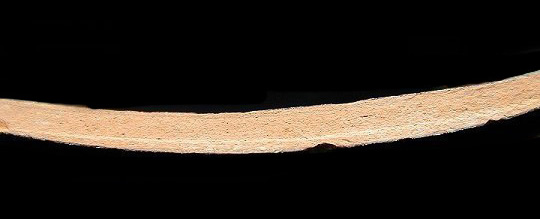
What type of earthenware does this paste and body belong to?
Astbury-type earthenware
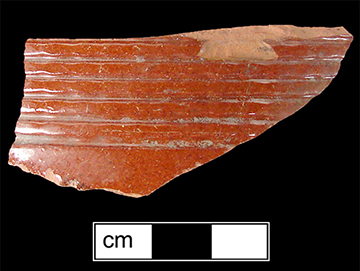
What type of earthenware do this body and shards belong to?
Astbury-type earthenware
What is the chronology for Astbury-type earthenware?
1720s-1750s
What colored paste does Astbury-type earthenware have?
high-fired red paste
What kind of forms are made of Astbury-type earthenware?
teapots, cups, bowls, and coffee pots
What kind of ceramic is North Devon?
A lead glazed coarse earthenware
What colored paste does North Devon earthenware have?
A reddish pink to orange paste that has a gray core
What colors does the lead glaze range from for North Devon earthenware?
The lead glaze ranges in color from green to yellow to brown
What defines the different types of North Devon Earthenware?
the temper
What is the chronology of North Devon earthenware?
mid to late 17th- and 18th century sites in the Chesapeake region

What kind of North Devon earthenware is this?
North Devon gravel-free
What is North Devon gravel-tempered characterized by?
Its gravel temper
What kind of forms is North Devon Gravel free found in?
in the form of tall (baluster) jars

What kind of North Devon Earthenware is this?
North Devon gravel-tempered
What colored core to North Devon earthenware have and why?
Gray, resulting from reduced oxygen during firing
Describe the paste for North Devon earthenware
Well mixed with a fine, smooth texture and contains very fine sand particles
Describe the paste for North Devon gravel temper earthenware
Angular gravel is added to the paste and imparts an obvious rough texture to the ware when it protrudes on the surface
Where are most North Devon vessels glazed?
on the interior
Are North Devon wares typically decorated?
They are typically undecorated
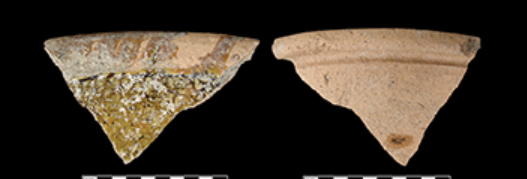
What kind of earthenware do these sherds belong to?
North devon earthenware
What color are Clouded and Tortoiseshell Refined Earthenware bodies?
cream-colored
What color do Clouded and Tortoiseshell Refined Earthenware become once they are decorated with a sponge?
Combinations of green, brown, purple, and yellow
Describe the material characteristics of Clouded and Tortoiseshell Refined Earthenware
They have a hard, somewhat porous body with thin walls.
How were Clouded and Tortoiseshell Refined Earthenware glazed?
They were Bisque (or biscuit-fired) wares that were dipped into a liquid glaze containing lead oxide, flint, and sometimes small amounts of clay
How are the clouded wares decorated?
They have amorphous patches of metallic oxides in combinations of green (copper oxide), purpose (magnesium), brown (iron), and yellow
What characterized tortoiseshell decoration?
consists of brown spots or streaks on the vessel’s creamy yellow background
-sprig molding was sometimes used as well
What forms did Clouded and Tortoiseshell Refined Earthenware take?
teapots, cups, plates, saucers, mugs, sauceboats, pierced baskets, and figurines
What kind of body and density did tin-glazed earthenware have?
They were soft-bodied earthenware ceramic
What kind of glaze did tin-glazed earthenware have
a lead glaze to which has been added tin-oxide
How were tin glazed earthenware often decorated?
They were often painted with blue and polychrome designs
Describe the paste used for tin earthenware
Course earthenware paste that is thick but with a soft texture, and untempered
What color did tin-earthenware paste have?
The colors vary from buff to pale-yellow to pink on English, Dutch, and Portuguese wares, while French and Italian tin-glazed ceramics may have reddish pastes
What colored glaze did tin glazed earthenware have
A clear lead glaze to which tin-oxide has been added , creating an opaque, generally whiter surface that was often decorated
0it separates easily from the body
What forms were made from tin-glazed earthenware?
Table and tea wares, decorate and commemorative plates, drug jars, ointment pots, tiles, and chamber pots
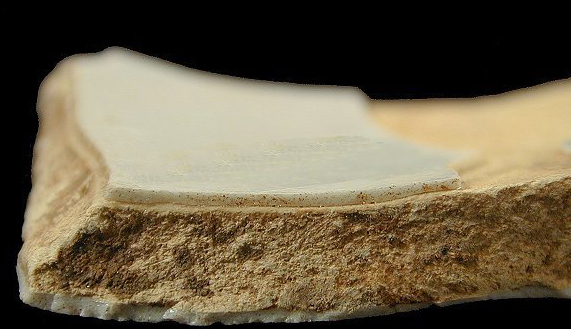
What kind of earthenware does this paste belong to?
Tin-glazed earthenware
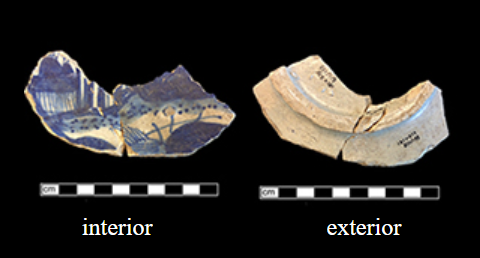
What kind of eartheware is this?
Tin-glazed earthenware
What colored paste did Buckley-Type earthenware have and how was it made?
A hard brick-red to purplish earthenware paste made by combining red and yellowish clays
Describe the density and design of the Buckley-type vessels?
They are often very thick with ribbed exteriors
What colored glaze did Buckley-type have and what was it made out of?
a thick black lead glaze

What kind of earthenware paste does this image show?
Buckley-type earthenware
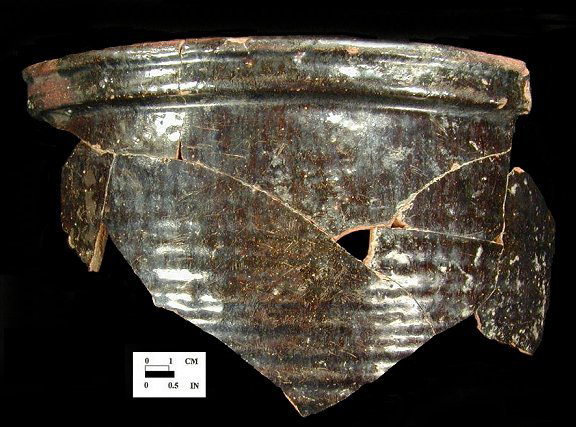
What kind of earthenware vessel is this?
Buckley-type
What is another name for Staffordshire-Type earthenware?
North Midlands
Describe the body of Staffordshire earthenware
Typically a thin, buff-bodied earthenware
What were staffordshire-type earthenwares coated with?
with white and dark slips
What were staffordshire type earthenwares decorated with?
trailed, combed, or marbled designs
What kind of glaze is used on Staffordshire-type earthenware and what color does it give the surface?
A clear lead glaze gives these vessels a yellowish background color
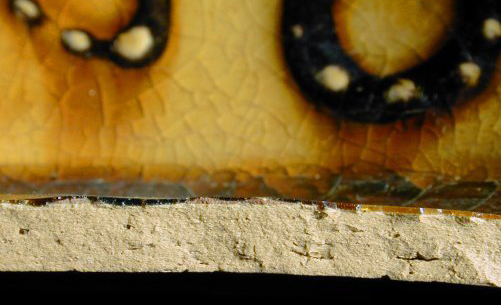
What kind of earthenware paste is this an image of?
Staffordshire-Type earthenware
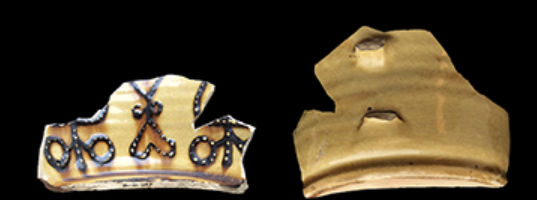
What kind of earthenware is this an image of?
Staffordshire-Type Earthenware
What does it mean for a ware to be vitrified?
It means that it is non-porous
What do the paste colors of stoneware range from?
Typically the color ranges from white to gray to stan
What is the most prevalent method used to glaze stoneware?
Salt-glazing
How does salt-glazing work?
During the firing, salt is introduced into the kiln. The sodium then reacts with silicates in the clays, creating a shiny, pitted surface, known as the “orange peel” texture
What color is English Brown stoneware ?
Generally a buff to light gray color
What is English Brown stoneware typically covered by?
Covered at least partly with a speckled brown slip and salt glazed
What does the body of English Brown stone ware have?
it often has small, dark inclusions in the paste (black pepper like)
What does English Brown stoneware most commonly occur as?
drinking vessels and bottles
Describe the body of English Brown stoneware
often a hard, grainy body that can be partly vitrified
-color ranging from whitish to buff to gray to light brown
How can you distinguish English brown from rhenish brown stoneware?
the dark inclusions and graininess that English brown ahs